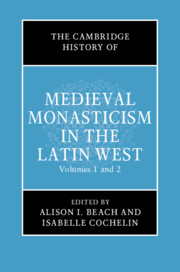Book contents
- The Cambridge History of Medieval Monasticism in the Latin WEST
- The New Cambridge History of Medieval Monasticism in the Latin West
- The Cambridge History of Medieval Monasticism in the Latin WEST
- Copyright page
- Contents
- Figures
- Contributors
- Acknowledgments
- Abbreviations
- 1 General Introduction
- Part I The Origins of Christian Monasticism to the Eighth Century
- Part II The Carolingians to the Eleventh Century
- Part III The Long Twelfth Century
- Part IV Forms of Monasticism in the Late Middle Ages
- 50 Late Medieval Monasticism: Historiography and Prospects
- 51 Sources of Late Medieval Monasticism
- 52 Monastic Liturgy, 1100–1500: Continuity and Performance
- 53 Books and Libraries within Monasteries
- 54 Art in Monastic Churches of Western Europe from the Twelfth to the Fourteenth Century
- 55 Lay Brothers and Sisters in the High and Late Middle Ages
- 56 Female Religious Life in the Twelfth and Thirteenth Centuries
- 57 Striving for Religious Perfection in the Lay World of Northern Europe
- 58 Monks and the Universities, c. 1200–1500
- 59 Bishops, Canon Law, and the Religious, c. 1140–1350
- 60 Daily Life in Late Medieval Monasteries
- 61 Monastic Preaching, c. 1350–1545
- 62 Research on Monasticism in the German Tradition
- 63 Satirical Depictions of Monastic Life
- 64 A Crisis of Late Medieval Monasticism?
- Index
- References
52 - Monastic Liturgy, 1100–1500: Continuity and Performance
from Part IV - Forms of Monasticism in the Late Middle Ages
Published online by Cambridge University Press: 16 January 2020
- The Cambridge History of Medieval Monasticism in the Latin WEST
- The New Cambridge History of Medieval Monasticism in the Latin West
- The Cambridge History of Medieval Monasticism in the Latin WEST
- Copyright page
- Contents
- Figures
- Contributors
- Acknowledgments
- Abbreviations
- 1 General Introduction
- Part I The Origins of Christian Monasticism to the Eighth Century
- Part II The Carolingians to the Eleventh Century
- Part III The Long Twelfth Century
- Part IV Forms of Monasticism in the Late Middle Ages
- 50 Late Medieval Monasticism: Historiography and Prospects
- 51 Sources of Late Medieval Monasticism
- 52 Monastic Liturgy, 1100–1500: Continuity and Performance
- 53 Books and Libraries within Monasteries
- 54 Art in Monastic Churches of Western Europe from the Twelfth to the Fourteenth Century
- 55 Lay Brothers and Sisters in the High and Late Middle Ages
- 56 Female Religious Life in the Twelfth and Thirteenth Centuries
- 57 Striving for Religious Perfection in the Lay World of Northern Europe
- 58 Monks and the Universities, c. 1200–1500
- 59 Bishops, Canon Law, and the Religious, c. 1140–1350
- 60 Daily Life in Late Medieval Monasteries
- 61 Monastic Preaching, c. 1350–1545
- 62 Research on Monasticism in the German Tradition
- 63 Satirical Depictions of Monastic Life
- 64 A Crisis of Late Medieval Monasticism?
- Index
- References
Summary
Monastic liturgy in the high and late Middle Ages was defined by a broad continuity of practice across time and place. From the later eleventh century, when the “Benedictinization” of monastic liturgy was complete (as described by Jesse Billett in this volume) to the sixteenth century and even beyond, the basic structures of monastic liturgical observance remained largely the same. Monks and nuns spent much of the day singing the divine office in services that corresponded essentially to the hours prescribed by the Rule of St. Benedict (RB). In addition to the psalmody of the office, the mass (often two daily masses) was part of the monastic day. The cycle of the year structured around the liturgy included various forms of ritual commemoration that shaped the experience of time and history in a monastic community. While individual elements varied among orders and houses, the long-term stability of the shared features created a continuous liturgical tradition over the centuries.
- Type
- Chapter
- Information
- The Cambridge History of Medieval Monasticism in the Latin West , pp. 958 - 974Publisher: Cambridge University PressPrint publication year: 2020
References
- 2
- Cited by



